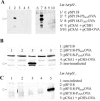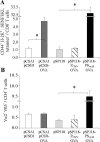Comparison of different live vaccine strategies in vivo for delivery of protein antigen or antigen-encoding DNA and mRNA by virulence-attenuated Listeria monocytogenes
- PMID: 16790768
- PMCID: PMC1489688
- DOI: 10.1128/IAI.00112-06
Comparison of different live vaccine strategies in vivo for delivery of protein antigen or antigen-encoding DNA and mRNA by virulence-attenuated Listeria monocytogenes
Abstract
Listeria monocytogenes can be used to deliver protein antigens or DNA and mRNA encoding such antigens directly into the cytosol of host cells because of its intracellular lifestyle. In this study, we compare the in vivo efficiencies of activation of antigen-specific CD8 and CD4 T cells when the antigen is secreted by L. monocytogenes or when antigen-encoding plasmid DNA or mRNA is released by self-destructing strains of L. monocytogenes. Infection of mice with self-destructing L. monocytogenes carriers delivering mRNA that encodes a nonsecreted form of ovalbumin (OVA) resulted in a significant OVA-specific CD8 T-cell response. In contrast, infection with L. monocytogenes delivering OVA-encoding DNA failed to generate specific T cells. Secretion of OVA by the carrier bacteria yielded the strongest immune response involving OVA-specific CD8 and CD4 T cells. In addition, we investigated the antigen delivery capacity of a self-destructing, virulence-attenuated L. monocytogenes aroA/B mutant. In contrast to the wild-type strain, this mutant exhibited only marginal liver toxicity when high doses (5 x 10(7) CFU per animal administered intravenously) were used, and it was also able to deliver sufficient amounts of secreted OVA into mice. Therefore, the results presented here could lay the groundwork for a rational combination of L. monocytogenes as an attenuated carrier for the delivery of protein and nucleic acid vaccines in novel vaccination strategies.
Figures







Similar articles
-
Listeria monocytogenes as novel carrier system for the development of live vaccines.Int J Med Microbiol. 2008 Jan;298(1-2):45-58. doi: 10.1016/j.ijmm.2007.09.002. Epub 2007 Oct 23. Int J Med Microbiol. 2008. PMID: 17936682 Review.
-
Yersinia enterocolitica Yop mutants as oral live carrier vaccines.Vaccine. 2008 Dec 2;26(51):6664-70. doi: 10.1016/j.vaccine.2008.09.020. Vaccine. 2008. PMID: 18822332
-
Fine-tuning the safety and immunogenicity of Listeria monocytogenes-based neonatal vaccine platforms.Vaccine. 2009 Feb 5;27(6):919-27. doi: 10.1016/j.vaccine.2008.11.047. Epub 2008 Dec 4. Vaccine. 2009. PMID: 19059297
-
Induction of CD8+ T cell responses by Yersinia vaccine carrier strains.Vaccine. 2005 Oct 10;23(42):4984-98. doi: 10.1016/j.vaccine.2005.05.027. Vaccine. 2005. PMID: 15985316
-
Listeria monocytogenes: a live vector able to deliver heterologous protein within the cytosol and to drive a CD8 dependent T cell response.Biologicals. 1995 Jun;23(2):135-43. doi: 10.1006/biol.1995.0024. Biologicals. 1995. PMID: 7546656 Review.
Cited by
-
Hematopoietic progenitor cell lines with myeloid and lymphoid potential.Nat Methods. 2013 Aug;10(8):795-803. doi: 10.1038/nmeth.2510. Epub 2013 Jun 9. Nat Methods. 2013. PMID: 23749299 Free PMC article.
-
Clinical Experience and Recent Advances in the Development of Listeria-Based Tumor Immunotherapies.Front Immunol. 2021 Apr 14;12:642316. doi: 10.3389/fimmu.2021.642316. eCollection 2021. Front Immunol. 2021. PMID: 33936058 Free PMC article. Review.
-
CD4(+) T Cell Priming as Biomarker to Study Immune Response to Preventive Vaccines.Front Immunol. 2013 Dec 4;4:421. doi: 10.3389/fimmu.2013.00421. Front Immunol. 2013. PMID: 24363656 Free PMC article. Review.
-
Colorectal cancer treatment using bacteria: focus on molecular mechanisms.BMC Microbiol. 2021 Jul 19;21(1):218. doi: 10.1186/s12866-021-02274-3. BMC Microbiol. 2021. PMID: 34281519 Free PMC article. Review.
-
Listeria and Salmonella bacterial vectors of tumor-associated antigens for cancer immunotherapy.Semin Immunol. 2010 Jun;22(3):183-9. doi: 10.1016/j.smim.2010.02.002. Epub 2010 Mar 17. Semin Immunol. 2010. PMID: 20299242 Free PMC article. Review.
References
-
- Angelakopoulos, H., K. Loock, D. M. Sisul, E. R. Jensen, J. F. Miller, and E. L. Hohmann. 2002. Safety and shedding of an attenuated strain of Listeria monocytogenes with a deletion of actA/plcB in adult volunteers: a dose escalation study of oral inoculation. Infect. Immun. 70:3592-3601. - PMC - PubMed
-
- Badovinac, V. P., B. B. Porter, and J. T. Harty. 2002. Programmed contraction of CD8(+) T cells after infection. Nat. Immunol. 3:619-626. - PubMed
-
- Corbin, G. A., and J. T. Harty. 2004. Duration of infection and antigen display have minimal influence on the kinetics of the CD4+ T cell response to Listeria monocytogenes infection. J. Immunol. 173:5679-5687. - PubMed
-
- DeGrendele, H. C., M. Kosfiszer, P. Estess, and M. H. Siegelman. 1997. CD44 activation and associated primary adhesion is inducible via T cell receptor stimulation. J. Immunol. 159:2549-2553. - PubMed
Publication types
MeSH terms
Substances
LinkOut - more resources
Full Text Sources
Other Literature Sources
Medical
Research Materials

